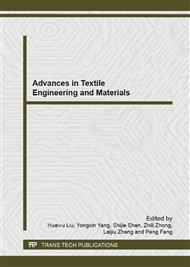p.85
p.90
p.96
p.100
p.105
p.110
p.117
p.122
p.125
Study on the Thermal Properties of High-Strength Flame Resistant Vinylon Blending Fabric
Abstract:
Making high-strength flame resistant of Vinylon short fiber blending strands into a fabric,testing the heat resistance and thermal conductivity of the fabric, according to the experiment data,the results is that, the adding of high-strength flame resistant Vinylon fibers is to ensure the mechanical properties and dimensional stability of the fabric when the temperature is not over 220°C.
Info:
Periodical:
Pages:
105-109
Citation:
Online since:
December 2012
Authors:
Price:
Сopyright:
© 2013 Trans Tech Publications Ltd. All Rights Reserved
Share:
Citation:


